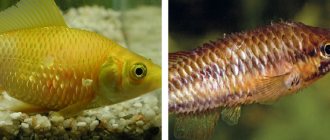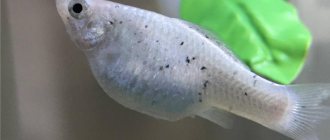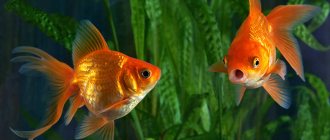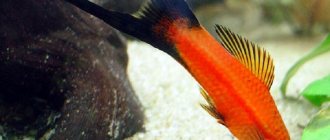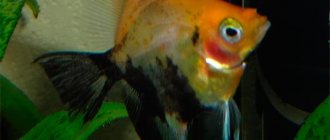Aquarium fish, like any other creature on the planet, are susceptible to various diseases. And one of the most common ailments is hexamitosis – it not only negatively affects the external beauty of the inhabitants of the aquarium, but can also lead to the most tragic consequences in the future. To avoid this, in this article we will talk not only about what it is hexamitosis (hole disease) in aquarium fish, but also consider the reasons for its appearance, symptoms, and effective treatment methods.
Hexamitosis (hole disease) in aquarium fish
Hexamitosis in fish - what kind of disease is it?
This is a parasitic disease of aquarium fish that affects the intestines and gall bladder. Visually, the disease can be easily identified by holes, ulcers and furrows of different sizes. Actually, because of this, hexamitosis is also called hole disease.
Hexamitosis in fish
In an aquarium, the disease develops due to the ingestion of a flagellate , an intestinal parasite that has a single-celled structure, into the body of fish. The external structure of the body of the flagellate resembles a droplet, the maximum size does not exceed 12 micromillimeters. There are also a pair of flagella on the body, which explains the name of the parasite. It is worth remembering that this parasite can reproduce even in an inactive state .
Note ! The flagellate can leave the fish's body along with their metabolic products, which is why it can be extremely dangerous for other inhabitants of the aquarium.
Holes and ulcers appear on the body
Fish susceptible to disease
Hexamitosis mainly occurs in salmon fish. Their side and head suffer the most. Fish that are more susceptible to the disease:
- cichlids;
- lapius;
- labyrinthine;
- gourami.
Other aquatic inhabitants are less susceptible to this disease. They may be carriers of the parasite for some time.
The following species can be carriers of this disease:
- guppy;
- battles;
- carp species.
Less likely to get sick:
- Macronagnathus;
- neons;
- catfish;
- acne;
- pimelodus.
Causes of the disease
According to most aquarists, hexamitosis of aquarium fish can appear due to failure to comply with basic rules for caring for the aquarium and its inhabitants. In particular, we can talk about:
- about the use of spoiled or low-quality food;
- about vitamin deficiency , a lack of minerals in fish, which provokes a weakening of the immune system;
- about excessive or, conversely, insufficient feeding.
Causes of the disease
However, numerous studies have shown that all of the above reasons, of course, are important, but are only auxiliary factors - they provoke the development of hexamitosis, but in no way cause it.
Thus, pathogens can enter the aquarium along with soil , water, poor-quality food or vegetation. Then the parasite does not reveal its presence in any way until the optimal conditions for it appear. Next, the flagellate begins to actively divide, thereby activating the disease itself. What is characteristic is that the result of the active phase is noticeable even to the naked eye. If infected fish are not treated promptly, they may die.
On a note ! Some scientists are confident that almost every aquarium fish contains the causative agents of this disease. Especially in young fish, fry .
Hexamitosis refers to diseases of the gastrointestinal tract with obvious external manifestations in the form of the formation of depressions, pits on the head and along the lateral line
It is curious that fish that have suffered from hexomitosis receive lifelong immunity . This indicates that the treatment has been carried out correctly and the body has successfully produced the necessary antibodies. Don’t forget: the disease is dangerous not only for sick fish ! The causative agents of hexamitosis form cysts, which are released along with excrement and can lead to the development of a real epidemic in the reservoir.
Pityriasis rosea in pregnant women
Pityriasis occurs more often in women than in men. It is especially dangerous when the skin disease occurs in pregnant women. If you notice any rashes, it is important to immediately visit a dermatologist and undergo treatment. It is unacceptable to risk the baby’s health and expect the plaques to disappear on their own. If the disease is not treated, then bacterial infections appear, which are much more difficult to deal with.
If a pregnant woman has not been diagnosed with pityriasis rosea, it is nevertheless important to adhere to the following recommendations:
- clothing made from cotton and linen is preferable to synthetic and woolen fabrics
- limiting heavy physical activity
- For hygienic purposes, use only warm water
- timely moisturizing of damaged skin areas
Symptoms of hexamitosis
At the initial stage, it is almost impossible to recognize the disease, which makes it extremely problematic to start treatment in a timely manner. The only indirect signs are a darkened natural color of the fish, sudden weight loss (even despite regular nutrition) or loneliness. If these symptoms are present, it is necessary to examine the pet as early as possible for the development of hexamitosis, so that the treatment provided in the future is effective.
Symptoms of hexamitosis
In addition, it is worth familiarizing yourself with the main symptoms of the development of the disease in a community aquarium.
- Decreased appetite . In a more acute form, the fish may completely refuse to eat food.
- Destruction, loss of fins.
- Picky eating . For example, a fish may grab food and then spit it out.
- Enlarged anal opening.
- Deep erosions in lateral areas . These erosions extend to the scalp.
- White mucous discharge . The disease affects the intestines, causing intestinal cells to be rejected and often released in large quantities from the body.
- Bloating . This symptom is observed mainly in cichlids. Usually, due to the disease, the shape of the abdomen and back changes.
Hexamitosis (Hexamita)
Note ! In addition, during the disease the external color of the inhabitants of the aquarium undergoes changes.
Typically, with hexamitosis, not all of the listed symptoms are observed. Sometimes white discharge even indicates poisoning or enteritis. However, you shouldn’t neglect what you see either. Ideally, the infected fish should be placed in a separate aquarium for examination. Then the ecological microclimate in the common tank will not be disturbed, and treatment with metronidazole will be more effective.
Video - Signs of hexamitosis in Malawian forest
Diagnosis of pityriasis
If you find suspicious spots on the skin, you should promptly contact a dermatologist. During a visual examination, the doctor assesses the nature of the rashes, their shape, size, location on the body and is able to make the correct diagnosis. After dermatoscopy, the following studies are additionally carried out: biochemical tests of blood and urine, RMP (microprecipitation reactions with antigens), skin scrapings from injured areas.
A more complex diagnosis is carried out if the skin disease lasts more than six weeks. In these cases, discharge from the affected lesions is sent for bacterial culture. A biopsy and subsequent histological studies will help make the correct diagnosis. In order to distinguish Zhiber's disease from other types of lichen, toxicerma, psoriasis, complicated syphilis and other pathologies, fluorescent diagnostics are carried out, scrapings are checked for the presence of pathogenic fungi, RPR tests are done for syphilis, etc.
Treatment of hexamitosis in aquarium fish
Today there are several options for treating fish for this disease. But when choosing one or another of them, you need to take into account what exactly became the catalyst for the development of the disease. Scientists have proven that hexamitosis in almost all cases is accompanied by a viral infection, and therefore the consequences of thoughtless treatment with metronidazole can be the most tragic.
Symptoms of hexamitosis (photo)
First of all, move the infected fish from the general aquarium to a separate one , which will serve as a kind of quarantine. Thanks to this, you will be able to avoid the development of the disease in the entire tank. Then increase the water temperature in the fish tank , the optimal values are 34-35°C.
Place infected fish in a separate aquarium
Important ! Due to such a sharp jump, the death of most of the parasites is possible. But you need to act carefully: before the procedure, be sure to familiarize yourself with the physiological characteristics of sick fish, because not all of them are suitable for the high temperature of the aquatic environment. For example, the use of this method for treating cichlids will be ineffective.
Another way to eliminate the disease is treatment with metronidazole . This antiprotozoal drug has repeatedly proven its effectiveness. And due to the fact that the substances contained in its composition do not affect the environment in any way, it becomes clear why many aquarists prefer metronidazole.
Treatment of hexamitosis with metronidazole
The drug can be used both in general and in quarantine aquariums. However, do not forget that the maximum permissible dose of the drug is 250 mg/35 l. Treatment with metronidazole should last 3 days, with regular water changes (about 25% of the total volume on the first day, 15% on the second and third). If treatment does not produce a noticeable result, then it is better to stop it.
On a note ! The first results of taking metronidazole will be noticeable only after a week. In addition, for preventive purposes, it is recommended to carry out medicinal baths every other week.
In addition to metronidazole, you can use other medications, since they are sold in every pet store. But before purchasing this or that product, be sure to consult with the seller to find out whether the treatment will harm the existing microclimate in the aquarium.
AQUAYER "Hexametril"
The most popular means are:
- Tetra Medica HexaEx;
- "Ikhtyovit Kormaktiv";
- ZMF Hexa-ex.
We also note that the maximum effect from the treatment of hexamitosis can only be achieved with an integrated approach.
Tetra Medica HexaEx
Some fish, as noted above, can only be carriers of the pathogen, and therefore it is not worth treating with just one drug. On the other hand, you need to be careful here. Experienced aquarists advise combining pharmaceutical preparations with branded ones. For example, 50 mg of Furazolidone per 15 liters of water simultaneously with Kanamycin (1 g per 35 liters). Add every day for 7 days, regularly replacing 25% of the total volume of water.
Important ! If you use the drug "Ciprofloxacin", then follow the dosage of 500 mg per 50 l. We recommend using ZMF HEXA-ex together with it (be sure to read the instructions on how to dilute the drug).
"Furazolidone"
Sometimes after treatment, fish may experience symptoms of toxicosis . If so, then urgently replace at least 50% of the water in the aquarium, and in the future use half the dosage of the medicine. Moreover, this applies to both branded and pharmacy drugs.
After the quarantined fish return to the general aquarium, carry out preventive measures there (within 4 days) to avoid a possible relapse.
Video - How to treat hexamitosis?
Also read : Fin rot of aquarium fish. In addition, you will probably be interested in knowing why fish die in an aquarium and what needs to be done.
A course of treatment
Since in most cases hexamitosis manages to spread throughout the aquarium, there is no point in removing one infected fish. Everyone without exception will have to be quarantined. Under no circumstances should water from a common container be used to fill the depositor. You will need to prepare the required volume in advance. Water must correspond to the parameters of the total capacity. Otherwise, a change in environment will cause stress in the fish, which will only aggravate the disease.
The best option to start treatment would be to raise the temperature to 33-35 degrees Celsius. The flagellate cannot withstand such heat. However, not all types of fish can survive in such conditions, so before heating you should read about the temperature conditions of each species in the aquarium.
In addition to raising the temperature, you will have to use special aquatic preparations designed specifically to eliminate a disease such as hexamitosis, or medications. Each drug comes with instructions with the appropriate dosage and method of treatment. As for pharmaceutical drugs, their uses and doses were described above.
Follow the dosage strictly and do not increase it, even if it seems to you that the treatment is not helping. High concentrations of medications can kill fish or cause damage to gills and mucous membranes.
You can also try feeding your pets medicated food, which will speed up the healing process and eliminate the possibility of residual symptoms. You will need dry food in granules, which does not dissolve well in water. Take 0.5 metronidazole tablets per teaspoon of food. The feed granules and tablet are then thoroughly crushed to mix the medicine into the feed. Next, water is added drop by drop to moisten the feed. You need to stop at the moment when the water appears at the bottom and stops being absorbed. We transfer the food back into the jar and leave it to swell. It can be stored in the refrigerator for about 2 days. You need to feed no more than 1-2 times a day.
In addition to metronidazole, kanamycin (1 g of the drug per 100 mg of feed), doxycycline (20 mg), levamisole (12 mg) and furazolidone (12 mg) are used.
When feeding medicinal food, you need to carefully monitor how the body and digestive system of the fish cope with it. If anxiety arises, food refusal occurs, or food is not digested at all, you should abandon the idea for a while. After a week, you can try again, but reducing the concentration by half.
Video : Treatment of hexamitosis with metronidazole, full course of treatment
Prevention measures
As mentioned above, hexamitosis develops when optimal conditions for it appear in an artificial reservoir. Therefore, preventive measures consist of constantly maintaining an ideal ecological balance in your artificial reservoir.
In addition, it is recommended to periodically feed the fish with certain medicinal foods containing substances such as spirulina, kanamycin and furazolidone. Also, you should not constantly use the same type of food. It would not be superfluous to purchase Fishtamin or Activant preparations for an artificial reservoir and then add them to the aquatic environment.
Prevention of hexamitosis
On a note ! You should also be very careful not to overfeed your pets and do not forget to check the level of nitrates in the aquatic environment.
Remember: hexamitosis causes almost irreparable damage to the digestive system of fish, which can ultimately lead to death. Therefore, following these simple recommendations can not only save the life and health of all inhabitants in an artificial reservoir, but also save you from unnecessary expenses on expensive medications.
Necessary measures upon detection
Since the pathogen is not only inside the fish, there is no point in placing it exclusively. We need to delete everyone.
However, if your aquarium contains many species for which not only basic parameters are important, but also the availability of their own space, you will have to allocate several aquariums to eliminate fights and reduce stress.
The flagellate moves freely in the water column, so water from a general aquarium cannot be used to fill the aquariums.
For this reason, you should prepare the required volumes of water in advance, making sure that the main parameters do not differ much, otherwise the inhabitants of the aquarium will experience shock, which will affect their health more than illness.

